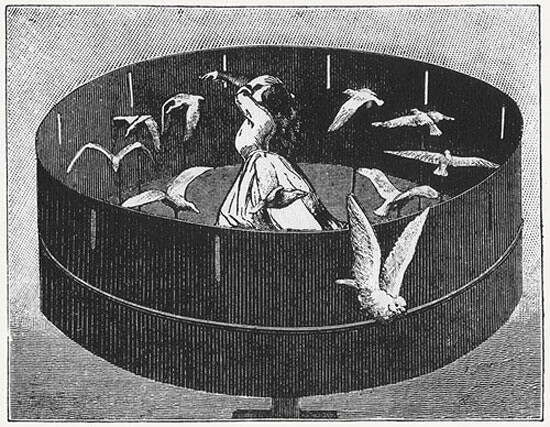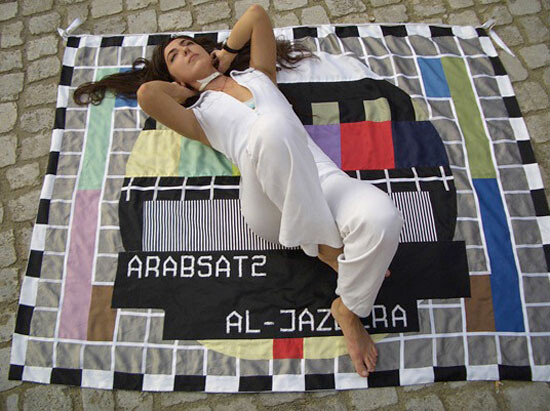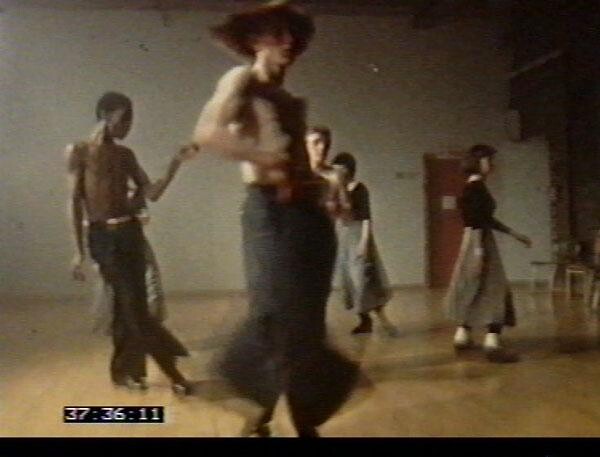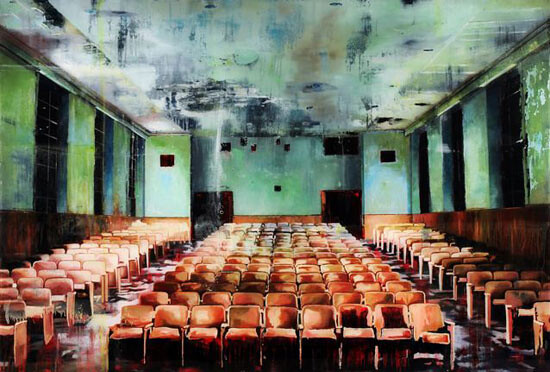Continued from “The Time That Remains, Part I: On Contemporary Nihilism” in issue 28.
To live is therefore also, always, to experience in the past the eternal amplitude of a present.
—Alain Badiou1
Is there a way out from the compulsive repetition that is symptomatic of our times? Boris Groys has defined the specific artistic gesture of the universalistic, messianic avant-garde through what he calls “the weak gesture of avant-garde” in opposition to the strong gesture of historicism as a form of domination in official culture. The avant-garde is not something that occurred once, but something that must always be repeated, precisely because it has been incorporated into the forgetfulness of historicizing culture and its ideology of progress. In this regard, the very notion of repetition, or even “re-volutio” understood as the circular temporal movement enacted by a self-repeating gesture, is inherent to the avant-garde.2 For Groys,
it is not enough to reveal the repetitive patterns that transcend historical change. It is necessary to constantly repeat the revelation of these patterns—this repetition itself should be made repetitive, because every such repetition of the weak, transcendental gesture simultaneously produces further confusion, and so forth. That is why the avant-garde cannot take place once and for all time, but must be permanently repeated to resist permanent historical change and chronic lack of time.3
To repeat here means to retaliate against historicism and against its devastating influence. Applied to the avant-garde, this notion of time enables us to retain modernity in our present as a “soteriological device,” one that may transform chronological history into suspended time.4
Returning to the concept of revolution as already inherent to the avant-garde, we can further suggest that the revolutionary gesture of avant-garde repetition is only the assertion of a specific subjectivity. Giorgio Agamben, in his discussion of temporality, differentiates between two ways of being in time: the “as if” type of chronological time versus the “as not” type of messianic time. The first lives as if he or she were “normal, as if the reign of normality existed, as if there were no problem … and this alone constitutes the origin of their discomfort, their particular sensation of emptiness.”5 In his Arcades Project, Walter Benjamin introduces the emblematic figures who occupy this empty temporality of perpetuation.6 Waiting in the nineteenth century was already the symptom of the “as if” type—signified by the player, the flâneur, and by a state of boredom (ennui). Each foretells modernism’s self-repeating phantasmagoria in our present.


In contrast, the revolutionary subject is defined through what Agamben calls “living as not” (the Paulian hos me, quasi non, as if not, or als ob nicht). In Agamben’s view, what is essential to this subject is not dogma or theory, but factual experience: an awareness of the way worldly relations are lived and “appropriated in their impropriety.”7 Realizing this avant-garde sensibility consists of a change of perspective within given conditions, not necessarily in the change of the conditions. It opposes the passive nihilism of society’s death drive, and the fundamental tendency of the symbolic order to perpetuate the same through continual displacement. In doing so it contests the basic conceits of linear time: the fetishization of history, mythologies that celebrate novelty and dynamic change, and the overriding imperative toward modernization. The condition of active nihilism can be seen as a political and philosophical mode of acting against waiting, acquiescent nihilism, and these modes of self-effacement.
This is what Baudelaire’s project of modernity was also about: an active transformation of detached ennui into an effective and self-reflexive spleen, made into a critical attunement to the nature of modern life.8 Obviously, Baudelaire’s distinction between an ennui-negativity and a spleen-negativity reflects both an aesthetic and ethical differentiation, as it does for Agamben, who elsewhere recasts this couplet to enable a more distinctive profile of the “as not” type as artist. By differentiating between a negative and a constructive negativity as elucidated by Nietzsche (the originator of this philosophical concept), Agamben gives it an operational quality:
This devaluation of all values—which constitutes the essence of nihilism—has two opposite meanings for Nietzsche. There is a nihilism that corresponds to “increased power of spirit” and to a vital enrichment (Nietzsche calls it “active nihilism”) and a nihilism that is sign of “decline” and impoverishment of life (“passive nihilism”).9
Nietzsche’s distinction between, on the one hand, a desire for destruction, for change, and becoming, a desire “pregnant with future,” and, on the other hand, a desire to fix, to immortalize, the desire for being prompted to creation,” gives us the means to reconsider the current situation of art within the double bind outlined in the first part of this essay.10 Nietzsche’s invocation from The Gay Science is, in this respect, pertinent: “Ah, if you could really understand why we of all people need art … but “another kind of art … an art of artists, for artists only!”11 We can understand Nietzsche’s call for the “destruction of aesthetics” as setting art and subjectivity beyond narrow notions of the work of art, the artist, and the public.
A positive devaluation of all values within the system of art might mean, as John Rajchman states, to “free the whole idea of ‘aesthetics,’ not only from the Kantian problematic of regulated faculties but also from the whole salvationist problematic of judgment or judgment day, connecting it instead to another unfinished sense of time.”12 Any contemporary assertion of an “ethically demanding negativity” within our current systems of aesthetic judgment is the symptom of their reification, but also the only possible resistance against it. The symptom of negativity can be made into a cure through repeated gestures of self-negating negativity—Nietzsche’s active nihilism.13


How, then, can we imagine today this novel sensitivity of an ethically demanding negativity that is able to assert the self-repetitive gesture of the avant-garde? Such a re-orientation doesn’t begin with the artist or the institutional system of art, but with the problematic of judgment. Let us not forget that the conceptual evaluation of aesthetics during German Idealism—the period of birth time for modern understandings of art and philosophy—was simultaneously accompanied by the discovery of reflexive judgment. It is no surprise that one of the most recent meditations on the state of art, provided by Jacques Rancière, reevaluates not the artist but the spectator as bearer of aesthetic evaluation. According to Rancière, every spectator acts as someone who observes, selects, compares and interprets:
This is the crucial point: Spectators see, feel and understand something in as much as they compose their own poem, as, in their way, do actors, playwrights, directors, dancers or performers.14
Redressing the function of both spectator and public means to avoid the allure and primacy of the object, which results, almost automatically, in an aesthetics of the work, the monopoly of the artist, and the art system as we know it, which, even in their contemporary perverted, nihilistic, postmodern configurations, are still based on categories of the homo aestheticus. What Rancière proposes is not a rupture or break within the historic continuum of works of art, or with the notion of the artist as such, but with the role of the spectator who guarantees the validity of aesthetic judgment. This means a break with universal concepts of judgment based solely on the notion of artistic geniality and the man of bon goût as a privileged and necessary agent. Such works of art, newly repositioned, cannot be constituted through an ex cathedra judgment, however noble and enlightened it might be, but through an organically growing palimpsest of decisions between emancipated spectators-as-quasi-producers.
Even for Kant the universal validity of judgment does not derive from determinate, preexisting concepts but from common sense, which is then reciprocally addressed as a universal category. We can ague that such an option is based on a constant negotiation of aesthetic criteria, which—and this is important—cannot be pre-established or strictly reliant on specialized competencies, but that function on the basis of changing cultural conventions and arrangements.15 For Groys the essential character of the avant-garde is that it is a democratic art. But, paradoxically, it is not popular with larger audiences, exactly because it is democratic:
Indeed, the avant-garde opens a way for an average person to understand himself or herself as an artist—to enter the field of art as a producer of weak, poor, only partially visible images. But an average person is by definition not popular—only stars, celebrities, and exceptional and famous personalities can be popular. Popular art is made for a population consisting of spectators.16
Elaborating on the notion of an active spectator, Rancière gives an answer to Nietzsche’s question of how anyone can understand herself as an artist: a fundamental aspiration of the avant-gardes. Beginning from a political view of the educator, Rancière rethinks learning as a specific cultural technology one of the first that creates actual audiences under conditions of passive reception. Designating the members of these groups as “embodied allegories of inequality”—positions of specific capacities and incapacities linked to various roles found most social distributions—Rancière argues that popular instruction produces inferiority in the form of stultification; lack of knowledge results in an inability to exercise creative intelligence and vice versa.17 “To be a spectator is to be separated from both the capacity to know and the power to act.”18 For Rancière, intelligence within this framework does not admit to differences of quantity, but of positions within a specific system that attributes capacities and maintains the distance between those who know and those who don’t know. If we extend Rancière’s concept of the “ignorant schoolmaster” beyond practical and intelligible matters (as he does), we can argue that the capacity of sensuous apprehension (aesthesis) extends to everyone.


This optimistic “devaluation of all values [of hierarchy and category]” that is implied in Rancière’s theory should be seen as an opportunity to rethink the art-spectator relation from the beginning. A universal judgment not based on the inculcation of inferiority signifies, in this respect, the possible aesthetic and political emancipation of the spectator.19 A work’s meaning is literally constructed by the viewers as it is subject to a negotiation and opposition on the part of the participating audience, which are both political and educational. As Rancière puts it: “Emancipation is the possibility of a spectator’s gaze other than the one that was programmed.”20 Moreover, the inclusion of everyone in matters of aesthesis equals an opportunity for a novel redistribution of the sensible—that is, both of the sensuous apprehension and of making sense. (The French word sens contains this double meaning.) Because aesthetic judgment is the universal condition for the world’s comprehension, the political implications of this proposal are immense. If aesthetic discussion is a matter of common consideration such that everyone has access to a decision-making that could change common sensibility—not just in art, which would cease to exist as such—then this new ethos can lead to the total abolishment of the narcissistic artist and of the consumerist viewer dependent on that disposition. This would also mean the abolishment of art as a monopoly—meaning art maintained by professional experts: curators, critics, dealers, collectors, advertisers, culture managers), those who, as Theodor Adorno remarks, “monopolize progress.”21 This would mean an end to art that acquires legitimation only because of its so-called educational and cultural value; art that is offered to a continuously ignorant and stultified public through state or privately funded museums and public art projects; and art that is substantiated by economic entities such as assets, profit or interest rather than the real needs of life.
One can set Rancière’s emancipated spectator within a broader concept of art as the state of “bringing forth.” In this phrase Heidegger conceives making art as something, “extended to every ability to bring forth and to everything that is essentially brought forth.”22 More narrowly, Heidegger describes the Nieztschean aesthetic capacity as “a relation to art of a creative or receptive sort,” which effectively reasserts the essential, aesthetic and even political position of the viewer.23 Putting a name to this capacity, Heidegger elaborates on the ancient Greek word techné, which is often translated as craftsmanship, craft or art, and he brings us toward a unique definition of art, that makes a clear distinction between art of the artist and the public: “Techné is often the word for human knowledge without qualification.”24In difference to techné the word episteme stands for the knowledge or science of quantifiable experts. For the ancient Greeks, polis politics is not linked to expertise and qualification, but is a capacity that can be actualized by doing; it is a civic way of life and an ethos for every citizen. That is why Plato speaks about politike techné and not episteme. What Rancière proposes is not a manual for how to do art, as has been often misunderstood; instead, he offers an answer to the question of what the artistic state should look like. In a truly democratic way—meaning looking at things from the standpoint of people or of civic society—Rancière demands an aisthetike techné, not an episteme, one addressed to all as political beings, that would advance art to an essential position within a political constitution.
For this reason, it is not a coincidence that the ancient amphitheater, the architectural dispositif of viewing and being seen, functions as Rancière’s emblematic figure of both political and aesthetic emancipation.25 The amphitheater unifies the two primary and essential arts of redistributing the sensible implicit in Rancière’s theory: dancing and building (assigning a site)—chorós and chôros. In this space, a redistribution of the sensible occurs within an affective framework as a transmission of sensuous and sensible affects passed from one body to another, from one ear to another. I believe it is in such contemporary dispositifs of placing bodies, of making and unmaking sites, of seeing and being seen, that such modern amphitheaters (not panoramas or panopticons) establish where the repetitive gesture of avant-garde can be performed.26


However this gesture cannot be guided by modernism’s aspiration to change social reality, or by “the dream of an art directly involved in producing the forms and the buildings of new life.”27 It may have the more modest goal to infuse reality with momentous breaks of perception that emancipate people, meaning to interrupt the programmed state of being with “dis-identifications” that construct new affective, discursive and pragmatic capacities: “Aesthetic experience has a political effect to the extend that the loss of destination it presupposes disrupts the way in which bodies fit their functions and destinations. What it produces is not rhetorical persuasion about what must be done. Nor is it the framing of a collective body. It is a multiplication of connections and disconnections that reframe the relation between bodies, the world they live in and the way in which they are ‘equipped’ to adapt to it. It is a multiplicity of folds and gaps in the fabric of common experience that change the cartography of the perceptible, the thinkable and the feasible.”28
In my view, this is also what Simon Critchley means with his argument for anarchism as an ethical practice, a mode of active nihilism understood as re-motivating means of political organization and aesthetics. The ‘deterritorialization’ of aesthetic judgment should be seen in this respect as a practice, which demands an emancipated spectator, one who exercises an interpretative and selective active looking, one who performs the repetitive and at the same time futile gesture of the avant-garde again and again, always producing peripheral and anarchic blind spots, signs of low visibility against the domination of historized and fetishized culture while continuously creating momentous dispositivs of sensuous time. The avant-garde doesn’t constitute an epoch; it is not just a historical period of art, the contents of which can be archived and reenacted, but rather a practical tool, a mechanism that enables the emergence of such ‘evental’ sites, and promises but never achieves with certainty the reconciliation of antinomies. The operations that define the way in which art weaves a community together are made according to Rancière, “en vue de – with a view to and in the hope of – a people, which is still lacking.” 29Repeating the messianic gesture of the avant-garde means to assume in an act of faith that this people exists.
Alain Badiou, Logics of Worlds. Being and Event, 2 (New York, London: Continuum, 2009), 510.
Equally, a “revolution” is a turn, a roll-back (revolutio), a strophé that is in search of its own temporal dimension. However, this turn also can be a diastrophé associated with Gianni Vattimo’s concept of the Heideggerian Verwindung, which explains our time, a concept that “contains no notion of dialectical sublimation (Aufhebung) nor of a ‘leaving behind’ which characterizes the connection we have with a past that no longer has anything to say to us.” This turning may appear to us as a sudden reversal of that which is expected: as both a sudden end and a reversal against (strophé kata). This katastrophé is a crisis that enables the opportune, the pivotal moment (kairos) to appear. Incidentally Alain Badiou’s retroactive constitution of the event, the temporality of the futur antérieur, which in his account has always a catastrophic dimension, connects the repetitive gesture of temporality to the revolutionary, terrible event. See Gianni Vattimo, The End of Modernity: Nihilism and Hermeneutics in Post-modern Culture, (Cambridge: Polity Press, 1991), 7.
Boris Groys, “The Weak Universalism” e-flux journal no. 15 (October 2010). See →.
Giorgio Agamben, The Time That Remains: A Commentary on the Letter to the Romans, trans. Patricia Dailey (Stanford,CA: Stanford University Press, 2005), 82.
Agamben, ibid., 36–37.
See Walter Benjamin, The Arcades Project, ed. Rolf Tiedemann (Cambridge MA, University of Harvard Press: 2002), passim and esp. 101-119.
Agamben, ibid., 34.
Jonathan Flatley, Affective Mapping. Melancholia and the Politics of Modernism (Cambridge, MA: Harvard University Press, 2008) 6.
Agamben, ibid.,86.
See →.
Friedrich Nietzsche, The Gay Science: With a Prelude in Rhymes and an Appendix of Songs (New York: Vintage, 1974), 37.
John Rajchman, Constructions (Cambridge, MA: MIT Press, 1998), 2.
The aristocratic version of this figure of negativity is found in Theodor Adorno, who, in The Philosophy of New Music, trans. Robert Hullot-Kentor (Minneapolis, University of Minnesota Press: 2006), declares radical and novel art—notably the music of Arnold Schönberg—to be “restricted to definitive negation.” In turn, for Edward Said, Adorno is a figure of lateness, “an untimely, scandalous, even catastrophic commentator of the present.” Although Said’s lateness: “fully conscious, full of memory, and also very (even preternaturally) aware of the present,” is tinted by ethno-biographical history, it could be easily be turned into a Nietzschean figure of active nihilism. Edward W. Said, On Late Style. Music and Literature Against the Grain (New York: Vintage Books, 2006), 13.
Jacques Rancière, The Emancipated Spectator (London and New York: Verso, 2009), 13.
Related models that deny strict categorical privilege and function would be Marcel Mauss’ gift economy, which produces consensus through a reciprocal obligation to offer, or Ernesto Laclau and Chantal Mouffe’s concept of “agonistic pluralism” as the basis of radical democracy. See Chantal Mouffe, The Democratic Paradox (London, New York: Verso, 2000), 80–107.
Groys, ibid.
Rancière, ibid, 12.
Rancière, ibid, 2.
Rancière has often pointed to Brecht’s Verfremdungseffekt aesthetic as a production model that will emancipate the spectator. See also Owen Hatherley, who has recently assessed the cinematic and avant garde components of Brecht’s Epic Theater in terms of their political and educational objectives and their functional democratization of the cultural apparatus.. Owen Hatherley, Militant Modernism (Winchester,UK, Washington, D.C., 2008), 116
Jacques Rancière, Fulvia Carnevale, and John Kelsey, “Art of the Possible,” Artforum (March 2007), 267.
Adorno, Philosophy of New Music.
Heidegger, Nietzsche,. 71. This is also Agamben’s view: “But the castle of culture has now become a museum in which, on the one hand, the wealth of the past, in which man can in no way recognize himself, is accumulated to be offered to the aesthetic enjoyment of the members of the community, and, on the other, this enjoyment is possible only through the alienation that deprives it of its immediate meaning and of its poietic (sic) capacity to open its space to man’s action and knowledge.” See Agamben, ibid., 111. The poietic in Agamben—from poiein “to pro-duce” in the sense of bringing into being—r—efers to the Heideggerian poet of truth (aletheia) who, in Alain Badiou’s view, is momentous, unpredictable and rare as opposed to Agamben’s homo aestheticus, the poet of continuation, application, and reiteration. See Alain Badiou, On the Truth-Process, An Open Lecture by Alain Badiou (2002). See →.
Heidegger, Nietzsche, 96.
Heidegger, ibid.,81.
The term amphitheater derives from the ancient Greek amphi-, meaning “on both sides,” and theasthai “to behold or view”,For one discussion of dispositifs in the current moment, see Agamben, What is an Apparatus and other essays, trans. David Kishik and Stefan Pedatella (Palo Alto, Stanford University Press: 2009), 1–23.
In this regard, the amphitheater functions as the political equivalent of the critical Deleuzian architectonic figure, the fold, see Gilles Deleuze, The Fold: Leibnitz and the Baroque, trans. Tom Conley (Minneapolis, University of Minnesota Press: 1992).. As with the distinctive operations of Deleuze’s many arts: film, literature, music and film, Rancière’s amphitheater is kind an abstract architectonic and operative generator that creates other spaces, “not by reducing sense but by multiplying it….It is not a matter of architectures that refer back to their own rules of construction and nothing else. Rather, it is a question of constructing free spaces of unregulation, undetermined by any prior plan, which so loosen an arrangement as to allow for sensations of something new, other affects, other percepts.” See Rajchman, Constructions,8. According to Deleuze, if philosophy creates “concepts,” the arts create novel qualitative combinations of sensation and feeling, so-called “percepts” and “affects.” For a discussion of the term “affect,” see Brian Massumi, Parables for the Virtual (Durham, NC: Duke University Press 2002). Equally, parallels can be drawn to Lacan’s baroque vision in which the topological figure of the torus, Lacan’s “doughnut,” constitutes an anchoring point in his theory of the constitution of a hollow subject. See Walter Seitter, “Lacans Barockismus” in Blühmle, Claudia and Heiden, Anne von der (ed.), Blickzähmung und Augentäuschung. Zu Jacques Lacans Bildtheorie (Berlin, Zurich: Diaphanes 2005), p. 355; Jean-Paul Assoun, Lacan (Paris 2003), p. 9, and Christine Buci-Glucksmann, La folie du voir. Une esthétique du virtuel (Paris: Galilée 1987).
Rancière, ibid, 78.
Such a position signifies a Rancièrian affective turn that leads us beyond our current aesthetic regime. Aesthetics for Rancière means the collapse of an isomorphic mediation, “the continuity between thoughts and its signs in bodies, and also between the performance of living bodies and its effect on other bodies.” In Rancière’s vocabulary this mediation defines the mimetic regime of art, which has ended with the advent of the modern aesthetic regime by the end of the 18th century. Rancière, ibid, p. 72 and 62.
Rancière, ibid, 57.

